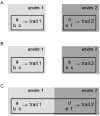Toward a population genetic framework of developmental evolution: the costs, limits, and consequences of phenotypic plasticity
- PMID: 20020499
- PMCID: PMC3151734
- DOI: 10.1002/bies.200900132
Toward a population genetic framework of developmental evolution: the costs, limits, and consequences of phenotypic plasticity
Abstract
Adaptive phenotypic plasticity allows organisms to cope with environmental variability, and yet, despite its adaptive significance, phenotypic plasticity is neither ubiquitous nor infinite. In this review, we merge developmental and population genetic perspectives to explore costs and limits on the evolution of plasticity. Specifically, we focus on the role of modularity in developmental genetic networks as a mechanism underlying phenotypic plasticity, and apply to it lessons learned from population genetic theory on the interplay between relaxed selection and mutation accumulation. We argue that the environmental specificity of gene expression and the associated reduction in pleiotropic constraints drive a fundamental tradeoff between the range of plasticity that can be accommodated and mutation accumulation in alternative developmental networks. This tradeoff has broad implications for understanding the origin and maintenance of plasticity and may contribute to a better understanding of the role of plasticity in the origin, diversification, and loss of phenotypic diversity.
Figures

References
-
- Van Tienderen PH. Evolution of generalists and specialists in spatially heterogeneous environments. Evolution. 1991;45:1317–31. - PubMed
-
- Moran NA. The evolutionary maintenance of alternative phenotypes. Am Nat. 1992;139:971–89.
-
- Schlichting CD, Pigliucci M. Phenotypic Evolution: A Reaction Norm Perspective. Sunderland, MA: Sinauer; 1998.
Publication types
MeSH terms
Grants and funding
LinkOut - more resources
Full Text Sources
Other Literature Sources

